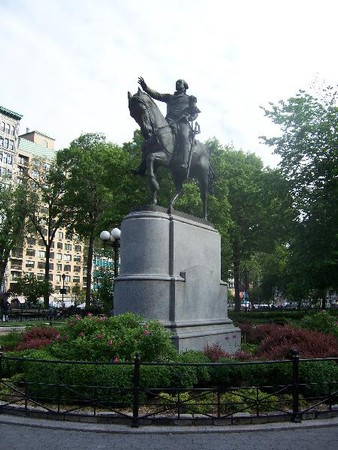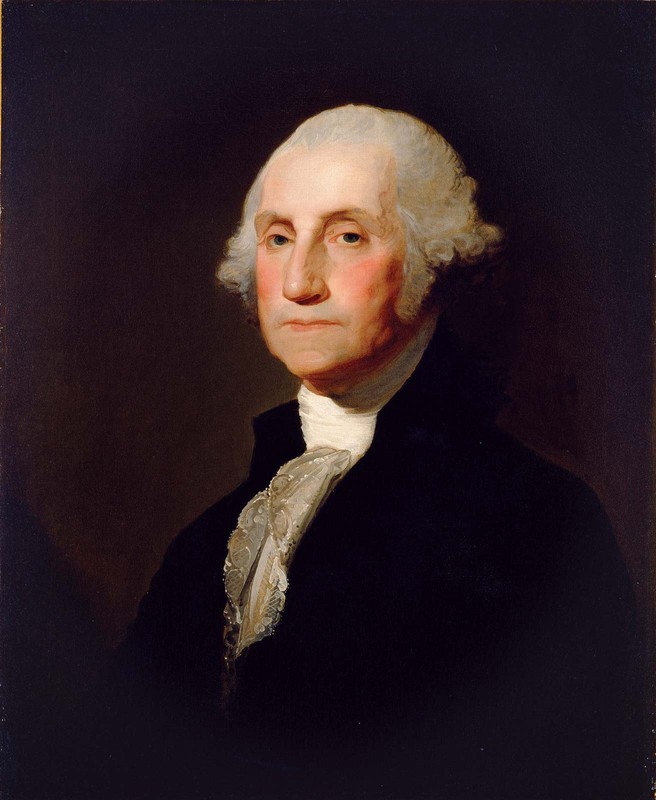George Washington Statue
Introduction
Text-to-speech Audio
Images
George Washington Statue

"George Washington" by Gilbert Stuart (c. 1803-05)

Backstory and Context
Text-to-speech Audio
George Washington was born into a family of wealth and privilege in Westmoreland County, Virginia on February 22, 1732. His father, Augustine Washington, was a prominent local planter who also served as a justice of the county court. A few years after his birth, the family took up residence at another one of their properties, Little Hunting Creek Plantation (later renamed Mount Vernon). In 1738, the family moved once again, this time to a plantation on the Rappahannock River called Ferry Farm. It was here that Washington spent most of his younger years. Despite his family’s elevated socio-economic status, he never received a formal education and never attended college. Washington’s only instruction during his early years probably came from private tutors hired by the family.
During the late 1740s, Washington commenced a career in surveying. After reading books on surveying and completing plans for small plots of land, he joined a surveying party put together by neighbor and friend George William Fairfax. During a month-long outing, Washington and the other men divided up a large land tract on Virginia’s western frontier into smaller lots. In 1749, probably as a result of his work for Fairfax, Washington received a commission to serve as a surveyor for the newly created Culpeper County.
In the 1750s, Washington’s attention increasingly turned to military affairs. He joined the Virginia militia and in 1753, by order of Governor Dinwiddie, embarked on a 900-mile journey to deliver a message to the French at Fort Le Boeuf near the shores of Lake Erie. The communication that Washington carried informed the French that Virginia claimed the area and demanded that they leave immediately. The following year, after the French refused to leave, Governor Dinwiddie sent Washington (now a lieutenant colonel) and about 150 men to the Ohio Country to assert the colony’s claims to the land. The expedition was a disaster (it resulted in the death of Joseph Coulon de Villiers, Sieur de Jumonville and Washington’s eventually surrender at Fort Necessity) and helped to spark the French and Indian War. After resigning his commission, Washington volunteered to serve as an aide to General Edward Braddock, who had orders to capture Fort Duquesne (present-day Pittsburgh) and drive the French from the Ohio Country. In July 1755, French forces and their Native American allies ambushed Braddock’s army near what is now Uniontown, Pennsylvania. Despite having two horses shot out from beneath him and four musket ball holes in his coat, Washington survived the ordeal. His conduct during the engagement helped to repair his reputation as a military commander and as a result he was given command of all Virginia’s forces. In 1758, Washington resigned his commission and returned to his home at Mount Vernon.
While enjoying the life of a gentleman farmer at Mount Vernon, Washington settled down and became involved in politics. In 1758, he began a nearly two-decades-long stint in the Virginia House of Burgesses. The following year, he married twenty-seven-year-old widow Martha Dandridge Custis. At Mount Vernon, Washington engaged in scientific farming, experimenting with fertilizers, methods of crop rotation, and livestock breeding. He also expanded the works of the plantation by building a gristmill and establishing a whiskey distillery, which became the largest in the United States by the time of his death in 1799.
At the Second Continental Congress in May 1775, delegates chose Washington to command the Continental Army. In the early years of the American Revolution, poorly-trained, ill-equipped, and often outnumbered, the Continental Army suffered many defeats at the hands of British forces. Washington, however, against long odds, kept the army together and, on several occasions, successfully prevented it from being captured. His stunning victory at Trenton in December 1776 helped to turn the tide of the war and his victory at Yorktown in October 1781 effectively secured American independence.
After the war, Washington resigned his commission and returned to Mount Vernon. His retirement, however, proved brief as national political developments required his attention. As a delegate from Virginia, he attended the Constitutional Convention in Philadelphia in 1787. Two years later, he was unanimously elected the first President of the United States. After serving two, four-year terms from 1789 to 1797, Washington retired to Mount Vernon. Before leaving office, he penned a letter to the American people (known to historians as Washington’s Farewell Address) that advised them to avoid political partisanship and long-term entanglements with foreign powers. On December 14, 1799, he died of a throat infection at the age of sixty-seven.
Just over half a century after Washington’s death, in 1851, a committee of New Yorkers with the intent of erecting a statue in honor of the nation’s first president approached two sculptors, Horatio Greenough and Henry Kirke Brown, and asked them to submit designs. When Greenough died unexpectedly in December 1852, the commission went to Brown. Dedicated in 1856 in Manhattan’s Union Square Park, the over-life-sized bronze equestrian statue, which rests on a granite pedestal designed by architect Richard Upjohn, depicts Washington riding into New York City on Evacuation Day (November 25, 1783), the day the British left the city for good. In the late 1920s, due to subway construction, the park was entirely demolished, but was reconfigured and reopened soon after. Consequently, the statue of Washington was moved from its original location on a traffic island in the middle of a street near the park’s southeast corner to the center of its south end, where it remains today. It is the oldest sculpture in the collection of the New York City Department of Parks and Recreation.
Sources
"Biography of George Washington." George Washington's Mount Vernon. Mount Vernon Ladies' Association. Web. 5 January 2021 <https://www.mountvernon.org/george-washington/biography/>.
Durante, Dianne. Outdoor Monuments of Manhattan: A Historical Guide. New York: New York University Press, 2007.
"George Washington." New York City Department of Parks and Recreation. The City of New York. Web. 5 January 2021 <https://www.nycgovparks.org/parks/union-square-park/monuments/1676>.
Pommer, Alfred and Joyce Pommer. Exploring Gramercy Park and Union Square. Charleston, SC: The History Press, 2015.
https://www.nycgovparks.org/parks/union-square-park/monuments/1676
https://www.britannica.com/biography/George-Washington
